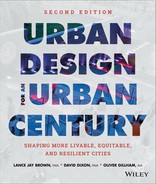Afterword
For a book that looks to the future of urban design, there is no more fitting conclusion than New Orleans.
Two months after Hurricane Katrina flooded the city, Governor Kathleen Blanco organized the Conference on Recovery and Rebuilding. Despite weeks of nonstop media coverage of the hurricane’s aftermath, the sight and stillness of New Orleans—now missing more than 300,000 of its residents—stunned conference-goers from outside the city, who joined roughly 700 New Orleanians to begin planning the recovery. The staggering losses told two distinct stories.
The first story spoke of a devastation impossible to comprehend fully—even while standing in its midst. Hurricane Katrina had achieved in one week destruction comparable to what in countless cities across America had taken decades of economic decline.
The second story offered more hope. New Orleanians from every walk of life, all of whom had weathered profound personal loss, crafted a vision for their city that was as humane as it was beautiful and as bold as it was realistic. Their vision could serve as a manifesto for twenty-first-century urban America: reinvigorate a tradition of lively Main Streets and historic neighborhoods that had long supported a rich mix of lifestyles; draw on cultural heritage to animate a public realm that invites people to cross long-standing racial divisions; reassert a tradition of economic innovation; reestablish the economic and social equity the city had enjoyed before losing its blue-collar economy; and commit to building resilience for a community too valuable to be surrendered to the impacts of global climate change.
Less than a decade later, this vision remains alive. After years of taking a laissez-faire approach to their city’s future, New Orleanians have committed to a new era of engagement—with each other and with the forces shaping their city. New Orleans adopted its first master plan in more than sixty years, and citizens voted to give it the force of law. An activist candidate, Mitch Landrieu, won election as mayor with a majority of both black and white voters’ ballots—the first time in history the city’s African Americans and whites had joined forces to support a single candidate. His administration moved forward with an agenda of transit expansion, neighborhood revitalization, and economic development that contrasted sharply with the city’s legacy of benign neglect.
Yet with its vision within reach, New Orleans—like virtually every American city—lacks necessary financial resources and tools. After decades in which public investment in its neighborhoods, Main Streets, and downtown failed to halt decline, New Orleans cannot afford to make essential investments in transit, public spaces, and resilience. The loss of eminent-domain powers has left the city unable to assemble scattered vacant sites, buy and clean up outmoded industrial buildings, and remove blight to unlock pent-up demand for private investment. Without the funding to build sufficient affordable housing, residents fearful of displacement fight to keep an elevated highway the proposed removal of which would restore a quality of life they once enjoyed, but which they now fear would drive them from their homes.
In the 1950s Josep Lluís Sert coined the term urban design in an effort to spur architects and planners to advocate for the funds and tools essential to revive U.S. cities at a time of unprecedented urban challenges. Urban designers must invoke that spirit again, this time to advocate for the funds and tools that can unleash an era of unprecedented urban opportunity.
